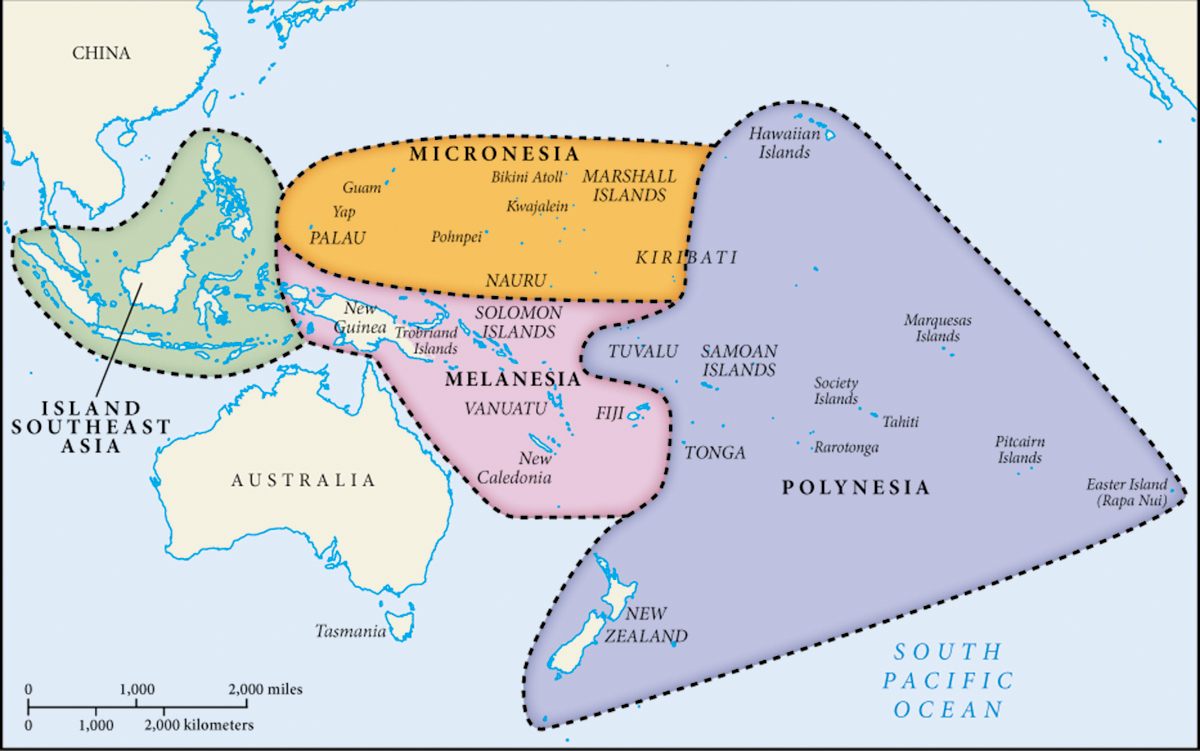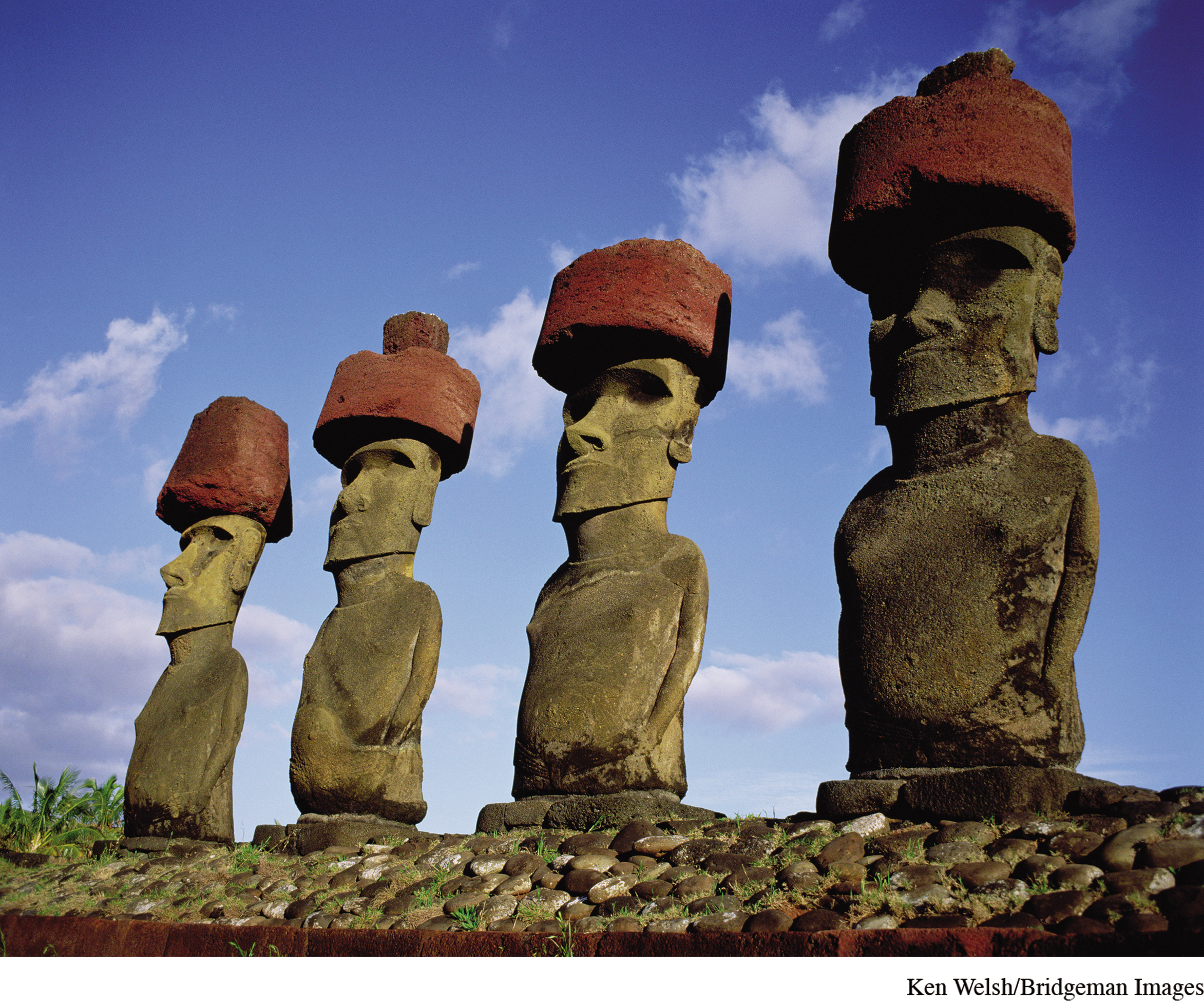Pacific Oceania: Peoples of the Sea
The peoples of Pacific Oceania, like those of Bantu Africa and North America, created enduring human communities without the large cities, states, and empires so prominent in civilizations. But the ecological setting for these historical journeys was distinctive, for they took place on the islands of the immense Pacific: a few larger territories, such as New Guinea and New Zealand, as well as thousands of much smaller islands, many of them specks in the sea, barely visible from space (see Map 6.5). New Guinea had been settled for perhaps 50,000 years, initially at a time when it was connected to Australia by a land bridge. But the rest of Oceania was the last part of the world to receive human settlers, who began arriving from Island Southeast Asia only about 3,500 years ago (see “Into the Pacific” in Chapter 1). By 1200 C.E., they had achieved a presence on every habitable piece of land throughout this enormous region. It was, as one historian summarized the process, “the greatest maritime expansion known to history.”19

The settlers’ arrival, however, produced an enormous and sometimes devastating environmental impact as humans entered and disrupted bountiful but fragile ecosystems, especially as their populations grew. Referring to some of the early settlers in Melanesia during the first millennium B.C.E., Pacific historian Ian Campbell wrote: “They hunted, gathered, and fished profligately, and burnt large tracts of previously undisturbed forests.”20 In New Zealand, initially settled much later, around 1200 C.E., human hunting largely eliminated the huge flightless moa bird within a century. Archeologists have discovered the remains of some 90,000 moa at a single butchery. A similar impact occurred in Hawaii and elsewhere as smaller birds fell victim to the rats, pigs, and dogs introduced by the settlers. Resource depletion, deforestation, and soil erosion followed, no doubt contributing to the abandonment of at least several dozen islands, as their inhabitants found themselves forced to flee or perish. Rapa Nui (Easter Island) in easternmost Polynesia had come almost to the point of ecological collapse by the time Europeans arrived in the eighteenth century, as much of its tree cover had vanished and many bird species had likewise disappeared. Human activity had surely contributed to this outcome with overhunting, overfishing, and the cutting down of forests. But Polynesian rats, whether introduced accidentally or intentionally by the original settlers to the island, were at least equally responsible, as their numbers exploded and they devoured the seeds of the palm trees.21
Another change occasioned by growing populations lay in increased social complexity on some of the most densely populated islands. One example comes from the Micronesian island of Pohnpei, where an urban complex, constructed from stone and coral, served as the ceremonial, administrative, and burial center of a powerful Saudeleur dynasty that governed the island for several centuries. Probably emerging in the tenth century, this impressive urban center, later dubbed by Europeans the “Venice of the Pacific,” contained numerous seawalls and canals, over ninety small artificial islands, marketplaces, and a large tomb and funerary complex. However, local legends tell of increasingly despotic rulers whose oppressive policies triggered a revolt by lower-
The Polynesian Tonga Islands witnessed yet another example of growing social complexity. By the fourteenth century, powerful rulers, known as Tu’i Tonga, stood at the head of a royal court including many wives and concubines, various relatives, ceremonial attendants, prisoners of war, and specialized craftsmen such as carvers, navigators, and fishermen. The court collected and redistributed food and various gifts to lesser chiefs, who then did the same for their followers. The widespread military and commercial influence of Tonga in the central Pacific has led some scholars to regard it as an incipient empire, while others view it as a tributary network or a system of economic interdependence.
Given the vast distances separating these island societies, considerable diversity among them is hardly surprising. And yet they also participated in the making of a single cultural region with numerous commonalities and connections. Many of their cultural and dietary similarities derive from their common origin in Island Southeast Asia and ultimately from southern China as well as from a common Pacific environment. Variations developed from the adaptation of this shared heritage to the distinctive environment of particular islands—
Linguistically, the peoples of Oceania, despite their small numbers, have spoken hundreds of different languages, over 100 on the small island chain of Melanesian Vanuatu alone. But almost all of them are members of the Austronesian family of languages, whose speakers also include those of Malaysia, Indonesia, and Madagascar. New Guinea, however, is a different story, with well over 1,000 languages, most of which are part of the Papuan language family, derived from its much earlier settlement. Similarly, Pacific islanders everywhere practiced the art of body decoration called tatau (which became “tattoo” in English), but particularly in Polynesia each archipelago developed distinctive designs, reflecting its unique identity.
This pattern of diversity and unity found other expression as well, both among the three major regions of Melanesia, Micronesia, and Polynesia and within them. In economic life, for example, these people of the sea drew heavily on the ocean as a major source of food, while its shells were used as currency and tools. But they were also farmers, raising pigs, dogs, and fowl, while everywhere cultivating taro, a starchy root vegetable. Other crops—
In political and social life, Oceanic societies were generally organized as chiefdoms, but with considerable variation. On small islands, chiefs and priests could hardly be distinguished from anyone else, while village councils, operating by consensus, made decisions. In parts of Melanesia, so-
Women everywhere in ancient Oceania were considered dangerous and polluting, especially during menstruation and childbirth, and were isolated at those times. However, gender roles differed substantially from place to place. In Melanesia, women were more actively involved in food production, but in Polynesia their labor was directed more toward the making of mats and cloth. Throughout Polynesia, women were accorded high status, and women of chiefly families could exercise considerable power through their male relatives. Melanesian women, by contrast, were more sharply subordinated to men than their counterparts in other regions of Oceania.

Religious life in Oceania was pragmatic, designed to protect against harm and to manipulate the spirits or gods in one’s favor. It found expression in two pervasive concepts: mana and tapu. Mana was a spiritual energy or power, associated especially with chiefs and demonstrated by remarkable actions or great success. To maintain the purity of mana, ritual restriction or prohibitions known as tapu (which came into English as “taboo”) served to make someone or something sacred or elevated far above the ordinary. Throughout Polynesia, only a particular official could handle the chief’s food or his possessions. A Maori chief in New Zealand could not allow even his shadow to fall on food, for doing so made it forbidden to all others. Hawaiians prostrated themselves on the ground before their major chiefs. Since violating a tapu could result in death, religion provided supernatural sanctions for political authorities and social elites, as it has in so many other societies. While much of this was common across all of Pacific Oceania, the gods, ghosts, ancestors, and spirits differed considerably, as did the role of priests or shamans as well as the associated rituals and artistic expression of religious life.
Despite the distances between these island societies, they were not wholly isolated from one another. Networks of exchange and communication—
In western Micronesia, another system of exchange arose in the Caroline Island chain, with a particular focus on the island of Yap. It involved trade in commodities such as sea turtles, coconuts, and breadfruit; permission to fish near neighboring islands; and promises of refuge and shelter in times of famine. But it was also a set of tributary relationships in which the high-
Polynesian networks of exchange also flourished in the centuries after 1000 C.E., with Tonga at the center of a system linked by trade with Samoa and Fiji. Finely woven Samoan mats were highly valued for displaying prestige, and large logs from Fiji were prized for the huge canoes that could be carved from them for Tonga’s impressive warships. From the far eastern edge of Polynesia, sailors had apparently reached the coast of South America, from which they returned with sweet potatoes and bottle gourds. Taking hold in Rapa Nui, those domesticates from the Americas then entered Polynesian voyaging networks and found their way to Hawaii, New Zealand, and elsewhere, becoming a major food source.
Linked to Asia by their distant origins and to the Americas by the slender thread of the sweet potato, the peoples of Pacific Oceania lived largely, but not entirely, in a world apart from the rest of humankind.